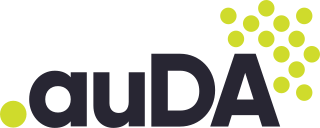The domain com is a top-level domain (TLD) in the Domain Name System (DNS) of the Internet. Created in the first group of Internet domains at the beginning of 1985, its name is derived from the word commercial, indicating its original intended purpose for subdomains registered by commercial organizations. Later, the domain opened for general purposes.

The domain name .org is a generic top-level domain (gTLD) of the Domain Name System (DNS) used on the Internet. The name is truncated from 'organization'. It was one of the original domains established in 1985, and has been operated by the Public Interest Registry since 2003. The domain was originally "intended as the miscellaneous TLD for organizations that didn't fit anywhere else." It is commonly used by non-profit organizations, open-source projects, and communities, but is an open domain that can be used by anyone. The number of registered domains in .org has increased from fewer than one million in the 1990s, to ten million in 2012, and held steady between ten and eleven million since then.

The domain name gov is a sponsored top-level domain (sTLD) in the Domain Name System of the Internet. The name is derived from the word government, indicating its restricted use by government entities. The TLD is administered by the Cybersecurity and Infrastructure Security Agency (CISA), a component of the United States Department of Homeland Security.

.us is the Internet country code top-level domain (ccTLD) for the United States. It was established in early 1985. Registrants of .us domains must be U.S. citizens, residents, or organizations – or foreign entities with a presence in the United States or any territory of the United States. Most registrants in the U.S. have registered for .com, .net, .org and other gTLDs, instead of .us, which has primarily been used by state and local governments, even though private entities may also register .us domains. The domain is managed by Registry Services, LLC, a domain name registry, on behalf of the United States Department of Commerce.
.ca is the Internet country code top-level domain (ccTLD) for Canada. The domain name registry that operates it is the Canadian Internet Registration Authority (CIRA).

.uk is the Internet country code top-level domain (ccTLD) for the United Kingdom. It was first registered in July 1985, seven months after the original generic top-level domains such as .com and the first country code after .us.

.ee is the internet country code top-level domain (ccTLD) of Estonia, operated by the Estonian Internet Foundation.

.au is the Internet country code top-level domain (ccTLD) for Australia. It was created on 5 March 1986. Domain name policy is managed by .au Domain Administration (auDA). As of July 2018, the registry is operated by Afilias.
Generic top-level domains (gTLDs) are one of the categories of top-level domains (TLDs) maintained by the Internet Assigned Numbers Authority (IANA) for use in the Domain Name System of the Internet. A top-level domain is the last level of every fully qualified domain name. They are called generic for historical reasons; initially, they were contrasted with country-specific TLDs in RFC 920.

.sg is the Internet country code top-level domain (ccTLD) for Singapore. It was first registered in September 1988. It is administered by the Singapore Network Information Centre. Registrations are processed via accredited registrars.
.za is the Internet country code top-level domain (ccTLD) for South Africa. The .za namespace is managed and regulated by the .za Domain Name Authority (ZADNA). Most domains are registered under the second-level domain .co.za.

.co is the Internet country code top-level domain (ccTLD) assigned to Colombia.

.tw is the Internet country code top-level domain (ccTLD) for Taiwan. The domain name is based on the ISO 3166-1 alpha-2 country code TW. The registry is maintained by the Taiwan Network Information Center (TWNIC), a Taiwanese non-profit organization appointed by the National Communications Commission (NCC) and the Ministry of Transportation and Communication. Since 1 March 2001, TWNIC has stopped allowing itself to sign up new domain names directly, instead allowing new registration through its contracted reseller registrars. As of May 2023, there are 17 registrars.

The domain name pro is a generic top-level domain in the Domain Name System of the Internet. Its name is derived from professional, indicating its intended use by certified professionals.
.zm is the Internet country code top-level domain (ccTLD) for Zambia. Registrants of .zm domains must "have a presence in Zambia".

.ky is the Internet country code top-level domain (ccTLD) for the Cayman Islands. The code was chosen as other possible options had already been allocated. Registration was limited to residents and registered companies in the Cayman Islands with a local address, but this restriction was removed in September 2015. The Cayman Islands also has the international three-letter code CYM and has won a bid to be awarded the .cym domain in a future expansion of the top-level domain space.
DotCooperation LLC is the Registry of the Top-Level Domain (TLD) .coop.

.au Domain Administration (auDA) is the policy authority and industry self-regulatory body for the .au domain, which is the country-code top-level domain (ccTLD) for Australia. It was formed in 1999 to manage the .au ccTLD with the endorsement of the Australian Government and the authority of the Internet Corporation for Assigned Names and Numbers (ICANN). It is a not-for-profit membership organisation that promotes and protects the .au domain space.
.college is a generic-top-level domain (gTLD) used in the domain name system of the Internet. It was delegated to the Root Zone of the DNS on 10 April 2014, completing the successful application for the string. The .college back-end registry operations are provided by CentralNic. Unlike .edu, .college is open for registration to the general public.











